Today, War Robots is among the Top 60 most profitable mobile games in the USA. But when it was launched, the team ran into problems that could drown the game. What kind of difficulties were they and how they were solved,” said Igor Klyukin, executive director of Pixonic, which developed the game.
The report was read at White Nights Moscow 2017. We have prepared a printed version of the speech.

Igor Klyukin
Now War Robots has more than 50 million installations. Up to 1.5 million people log into the game every day. Income is also measured in millions. Players from all over the world play. The top regions are the USA, China, Japan and Korea.
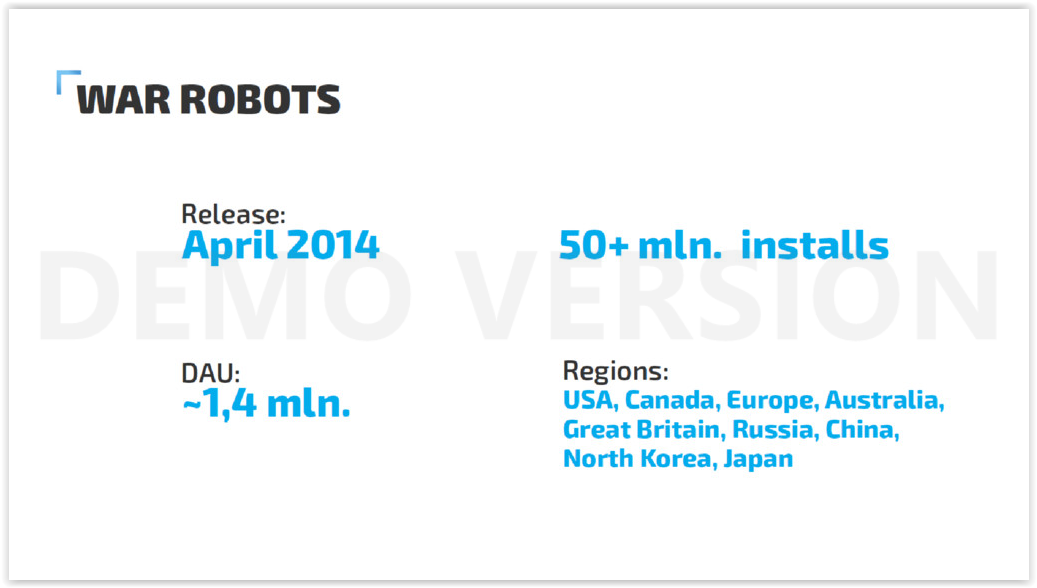
We did not come to these indicators immediately.
Inspiring beginnings and first challenges
It all started in April 2014. We were preparing to release a playable version of the game with minimal content and a minimum amount of functionality into softlonch. We wanted to test how successful our idea of a game about big, giant walking robots is.
Since we have a multiplayer game, we needed to catch up with a sufficient amount of online. The marketing director and I figured out how many installations are needed to provide players with online. Now we have fights taking place 6 on 6, at that time we set up fights 4 on 4. Anyway, at the same time, online should have been of a fairly high level.
The plan was as follows: on Monday we release, post a version, on Thursday, if no bugs are found, we start advertising campaigns and by Sunday everything accelerates, because the audience is most active on weekends.
That was the plan.
On Tuesday evening, I look into the internal analytics and see that we have received 10 thousand installations this evening. I call Artem, our marketing director, and ask: “Why not according to plan?”. Artem says it’s not us.
In short, our game gained 200 thousand installations in the first month after its release. There were no features, the marketing budget was minimal.
As I later realized, when I restored the events, in one of the VKontakte public sites dedicated to mobile games, they wrote that a new game had appeared, it was worth downloading it. Then it went on to other smaller public sites. Then the players started recommending War Robots to each other.
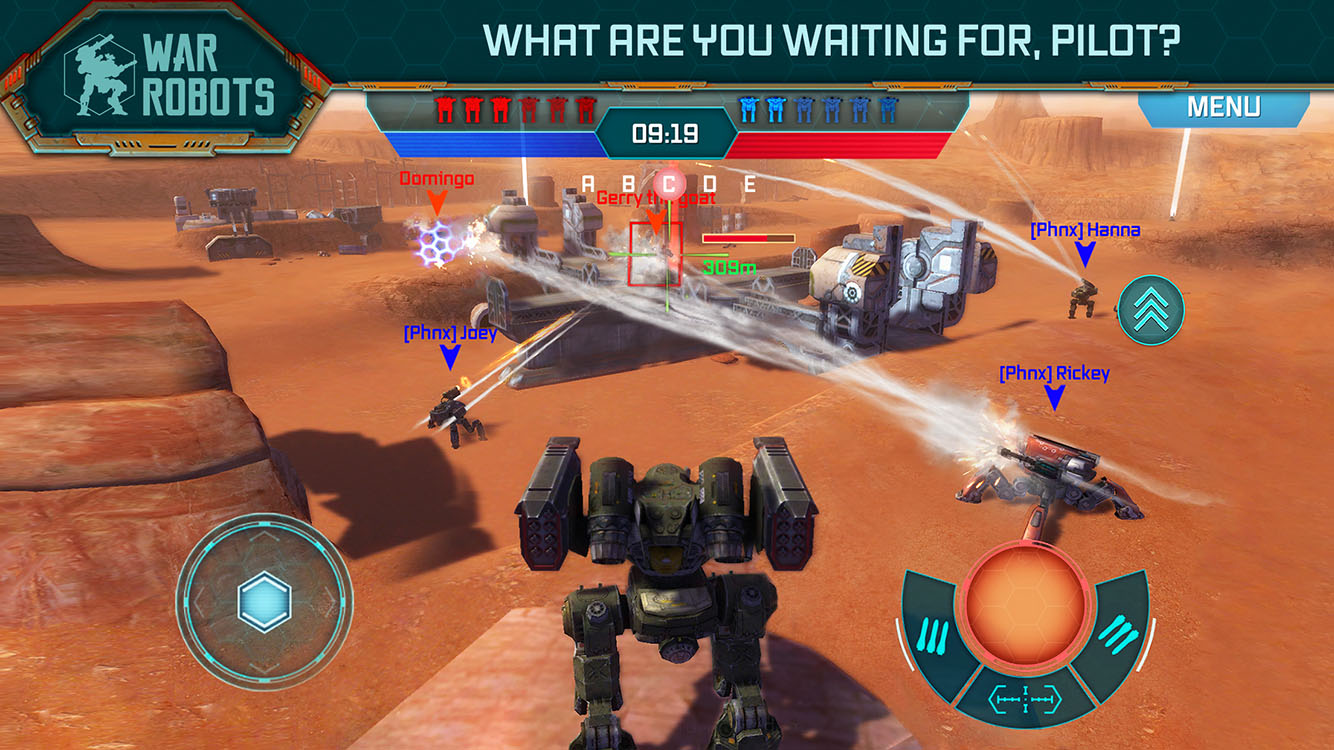
It would seem that this was the beginning of the success story. What else is needed? 200 thousand installations just like that!
In fact, there was no miracle. In the next month, only 50 thousand installations came. Marketing did not pay off, because the performance of the game was low at the start. Moreover, since we posted the game with a minimal set of content and features, and this content was “eaten out” in just a few weeks, good reviews quickly gave way to criticism.
The players demanded to supplement the game: add robots, add guns, add some features, add goals, fix bugs, correct the balance. At the same time, of course, few people paid.
The development team was inspired by the reaction of the players. On the one hand, the idea turned out to be successful, on the other – there was negativity and criticism. The development team started adding new features with a vengeance.
Features after launch
In the early concept of War Robots, there was such a feature as repair. It worked like this: you fight, the robot gets damaged and after the battle is unavailable for subsequent battles, it gets repaired. It could take from 15 minutes to 8 hours. To skip the repair, you had to pay with “software”. It was possible to spend more on repairs than to earn in battle.
In one of the first additions to the game, we added additional repair monetization. You could “hard” pay for a subscription to the robot. After that, he no longer stood for repairs.
The game Center and the “Game with Friends” were integrated into the game.
If you and a friend are friends with someone in Game Center, and both play War Robots, you can send each other invitations and play in the same match for the same team. This is an engagement feature. And also for hardcore fans who quickly consume all the content.
We also added player ratings. There were several nominations in total: hourly, daily and weekly. In each nomination, the leader of the list received a prize. This feature is both for engagement and monetization.
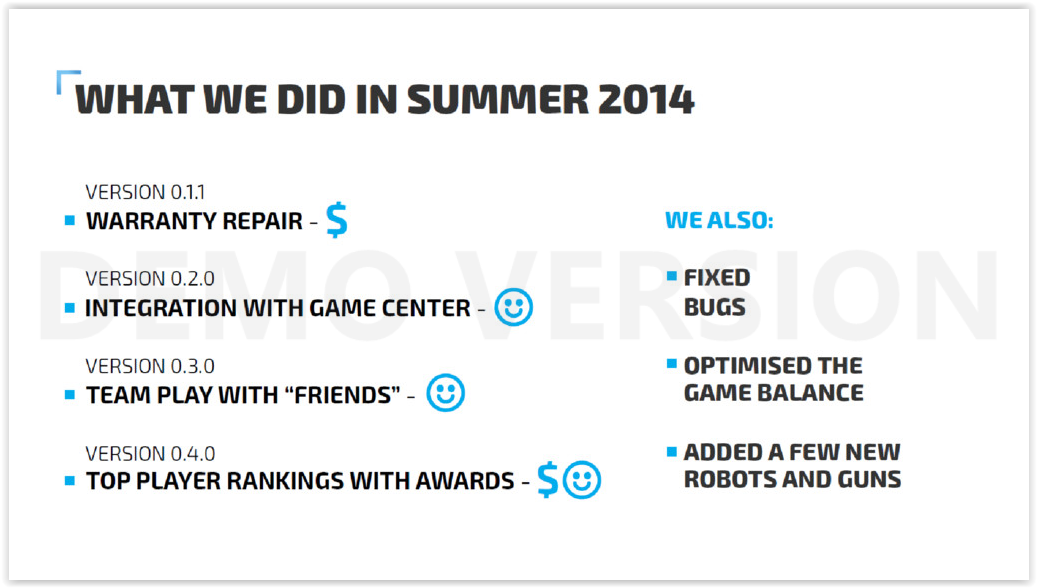
At the same time, the team added new robots and guns to the game, constantly fixed bugs, balance rules. The work was in full swing. The team did not have time to “exhale” after the release, as they began to work with a vengeance on updates, on adding everything they wanted, planned, but postponed until the soft launch.
Meanwhile, the indicators did not change in any way. The studio was going through hard times. Philip Gladkov and I spent all our efforts so that the team could continue working on War Robots. We had to reduce some other developments. We were on the front line, the team had to correct the indicators at that time.
Shock work, unfortunately, was not enough. It wasn’t enough. Therefore, we talked with the producer and decided that I would participate in further development and plan subsequent releases.
Innovation errors
We started by figuring out why everything the team had done before didn’t work. The team, I note, is professional, working hard.
It turned out that the features that were introduced into the game were introduced into it at the moment when most of the players “fell off”. Players simply did not reach this content, they “fell off” in another place and for other reasons.
The introduction of Game Center was made with a mistake. The connection to the Game Center was made as in the Supercell games, except for one small nuance: at the beginning of the game, Supercell could press “Cancel” and play on, and with us, if you press “Cancel”, you could not play on. The development team didn’t really understand the importance of the first session. Developers and testers saw how it was implemented, but apparently decided that it was necessary.
At this step, 40% of our players fell off: not everyone likes Game Center.
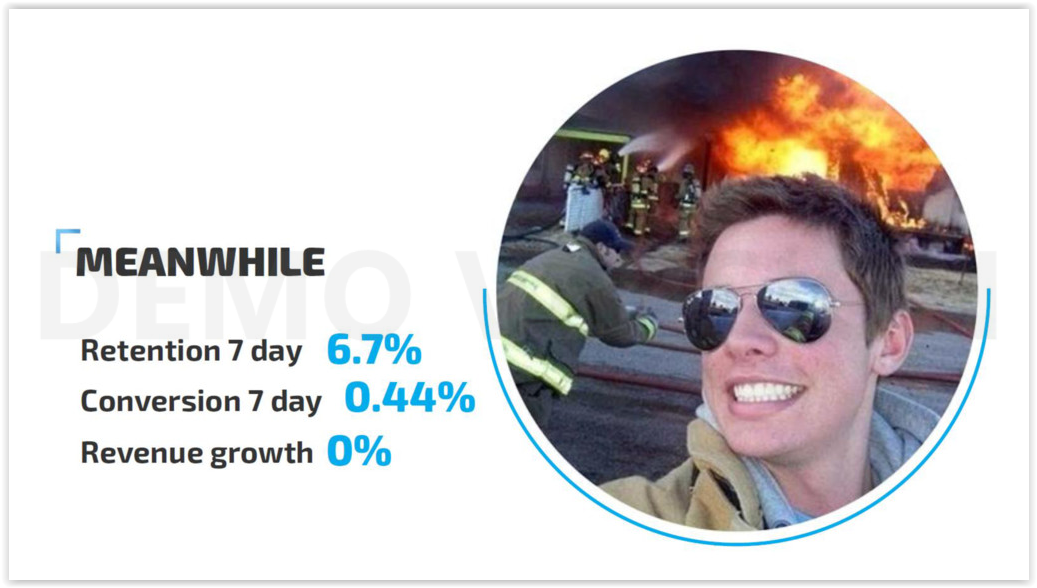
The repair feature, which was at the head of the game’s economy, turned out to be a killer for the game. It worked in such a way that some players earned a lot of money, and they didn’t have to pay for anything, while others went into the negative and left the game. Monetizing this feature – making a premium subscription for “hard” robots – also turned out to be a bad idea.
Due to the fact that the economy of the game was poorly configured, the introduction of new content did not lead to anything. No matter how many robots and guns we introduced, it did not affect payments in any way.
Fixes of bugs and balance occurred according to unclear priorities, and the effect was appropriate.
As for the rating of players, which was supposed to give content and money, this also did not work: only hardcore players used the rating. To get to the top of this rating, you had to play the most. You couldn’t help yourself with money here. It turned out to be a feature for a small layer of hardcore fans. They must have been pleased.
Problem solving
We turned to analytics, we dropped all the “wishlist” hardcore players who shouted the loudest in the community, dropped their “wishlist” that we wanted to do in this game. Everything was put in the backlog. A cool idea arose, we wrote it down in the backlog and calmed down.
We focused on the most important thing: the newcomers and their problems that they face in the first minutes and hours of the game. And, of course, on creating payments from players. Money is also needed to maintain life in the studio. These were two important things.
At first, we refused this feature with repairs. We have reduced its influence and made it so that there is no choice between becoming a robot on a timer or not. Everyone just wrote off the “software” automatically at the end of the fight. Thus, we reduced the impact of the feature.
Since we have abandoned this feature, then a subscription to the robot has become unnecessary. We changed it to a normal, understandable “premium subscription of a healthy person”, which is understandable to players from other games. If you subscribe for a certain number of days, then you get increased experience and increased “software”.
It worked, people started paying. And it was done through IAP’s, not for “hard”.
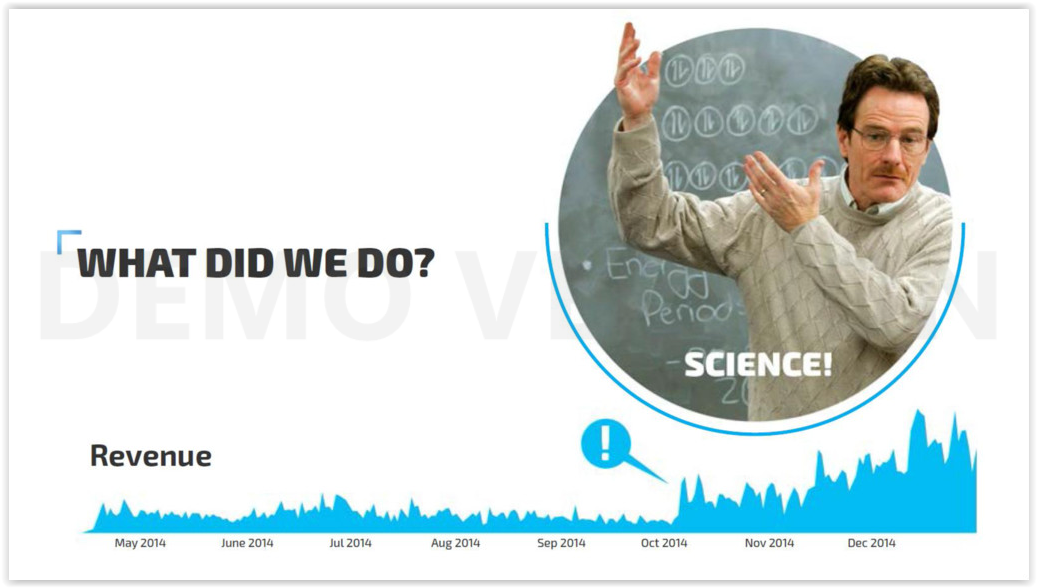
Since the content for “software” was eaten up quickly, and the economy was ruled for a long time, we introduced premium content that is bought only for “hard”. People started paying, buying “hard”, buying content.
We also took up economics. Instead of the endless balance edits that always happen (we still change the balance and will change throughout the life of the project), we started doing economics.
We started prioritizing bugs, the most massive and critical ones first of all.
We introduced combat training for beginners and started simplifying the most frequent and complex user cases.
On the last point, I will give an example. One of the features of War Robots is the ability to use several robots in battle. Killed one – you land on the other and go back into battle. This can be done up to five times per fight. Therefore, beginners almost immediately face the task of buying and arming their second robot. And we have a problem in the game: the interface is heavy. Buying a robot, upgrading, moving back and forth – it’s all complicated. And in early versions of the game, working with the UI resembled black magic.
Here are the early interfaces of War Robots. You need to buy yourself a second robot. Where will you click? “Buy a robot”? It makes sense! But no. You will buy a robot instead of the robot that you have! To buy a second robot, you need to click on the empty space on the right, open the second slot and buy a robot there!
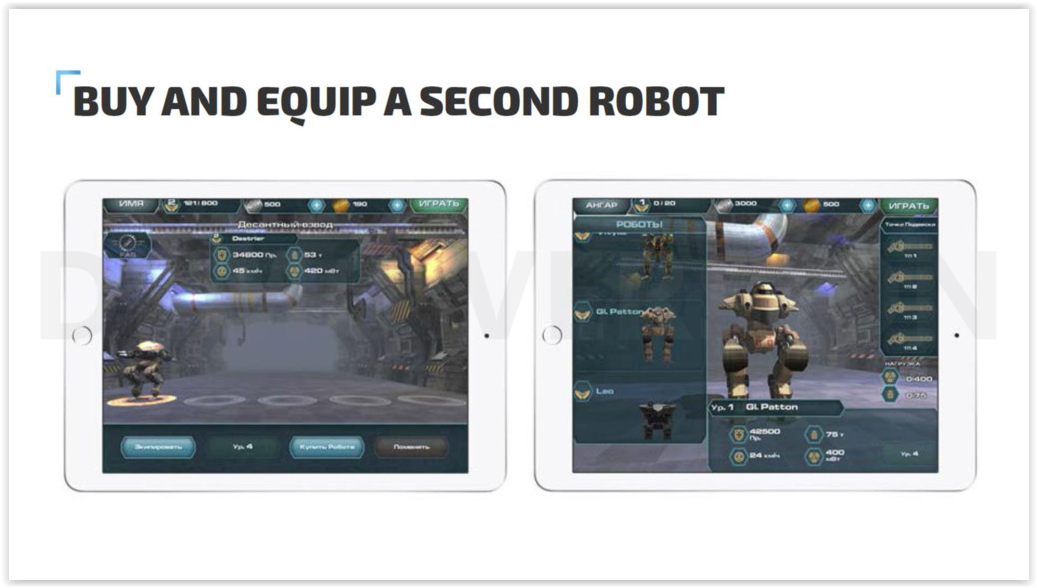
But the story doesn’t end there.
We can move weapons from robot to robot. We can create a custom build with rocket launchers, lasers, guns.
It sounds great, but there is a nuance. We sold robots without weapons. You had to go in and choose what kind of weapon you want to make. This is an even more difficult quest!
We solved the problem with buying a robot by adding a large “Open slot” button. Then, when you open the slot, it changes to the “Buy robot” button. This is a duplicate function, but solves the problem.
We have removed unnecessary information, highlighted the information that we need, implemented a cool feature “Recommendations”. Now, to improve the robot, it was not necessary to descend into the layers of UX twilight. The new UI started explaining what you need to improve. The same button recommends speeding up the improvement timer.

After this innovation, 35% of all upgrades and “skips” began to occur on this button.
We also decided to sell robots already with guns, with pre-installed bases. So that the player, as soon as he bought the robot, could immediately play. If he wants to change weapons, try his build, he will do it at the right time. Most importantly, the need to buy guns has ceased to be a limiter. The user can play immediately by purchasing a robot.
Do not throw anything out of the project thoughtlessly
Fritupley projects will always change after launch. It is impossible to create a game and not have it changed for several years. So it is with us in War Robots.
This summer we changed the combat UI. We decided that we want to add new modes. To do this, it was necessary to change a lot in the combat UI. The old code does not scale. So, you need to change it.
We changed the visual, changed the code, but almost did not change the functionality, because it is convenient to play with us.
What did the coders do? The old code was recognized as incorrect, thrown away, written from scratch. We didn’t understand how the old code worked.
After the release, it turned out that we had lost several small features that had been added to the old code over the past years and successfully forgotten. For example, we have lost the automatic scaling of control sticks for devices with exotic extensions. Naturally, we quickly identified it, corrected it, fixed it, but, again, if we had studied how the old code works, we would not have made this mistake.
The bottom line is that if you change something in the game, even if it’s something bad, you have a lot of users who are used to it, use it, have formed their user cases around this feature. You can’t just mindlessly take this bad thing and throw it away. This is not a development. In development – it is possible. Refused the feature, introduced a new one.
Be afraid of “trains”
One more piece of advice.
A year ago, the artists decided to optimize a couple of effects. Smoke, explosions from rockets. And they realized that they needed to contact the coders to correct several aspects. The coders said, “Oh! And we’ve been wanting to rewrite this whole system for a long time! We’re going to rewrite it all now!”. Then the game designers found out about it, and they say: “By the way, since you got there, let’s redraw the visual. And we have several new mechanics coming out, we want to support them with a visual too. Machine guns are firing, heating up, let’s do it too.”
This “train” loaded with new “wagons” was traveling for about 9 months. And all the “wagons” wanted to come to different places. In that release, when the “arrival” was scheduled, the QA team laid down their bones, said: “We are not posting this. It’s impossible.”

Then, after some time, it was all cut into separate tasks. Some people suffered in the process, abandoned their ideas. In general, we spent a lot of time and effort. Don’t do that. Do without “trains”.
This approach generally refers to a lot of things, not only to game development, but in general to the management of the company. It is impossible to “blind” ideas, it is better to introduce them separately.
I told about our mistakes for a reason. I want everyone to learn from the mistakes of others and not breed stupidity. There is enough of it in this world already.
